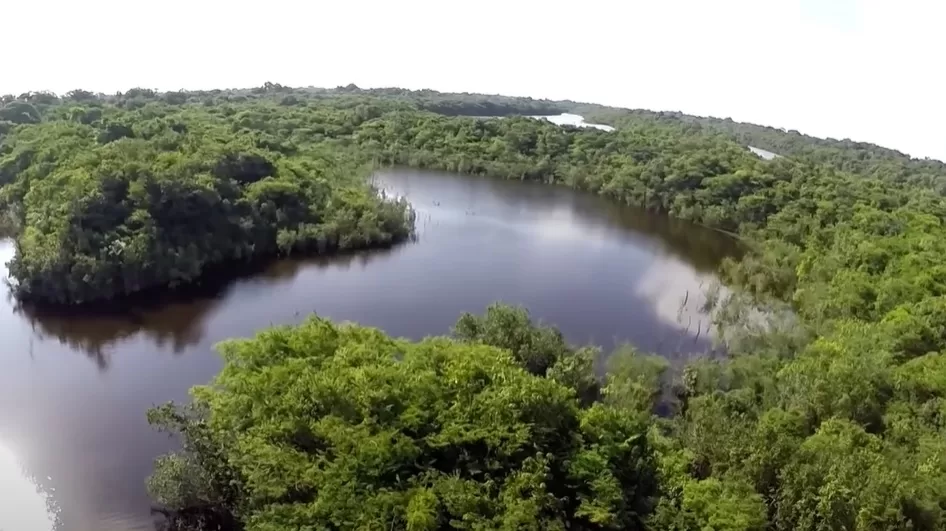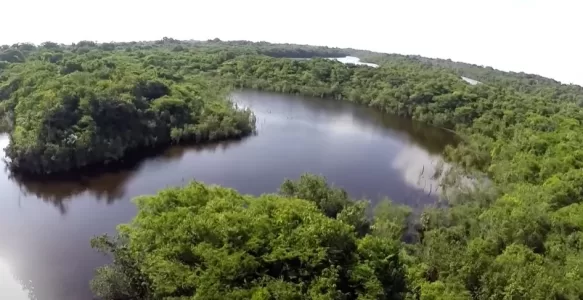The Amazon, known as the world’s lungs, is a vast and intricate region that hosts an unparalleled diversity of ecosystems, species, and human communities. Among its many gems, the Anavilhanas Archipelago stands out as the largest fluvial archipelago in the world. Located in the heart of the Amazon rainforest, on the Negro River, this collection of islands is a true natural wonder that combines beauty, biodiversity, and ecological significance in a unique way.

Location and Extent
The Anavilhanas Archipelago is situated approximately 80 km west of Manaus, in the Negro River region, one of the most important transportation routes and biodiversity hotspots in the Amazon. Spanning roughly 150 km in length and varying between 12 km in width, the archipelago comprises around 350 islands distributed across areas of tropical forest, flooded zones, and sandy beaches. This extensive landform results from geological and hydrological processes that have shaped the region over millions of years.
Its strategic location and impressive size make the Anavilhanas Archipelago one of the largest fluvial archipelago areas on the planet, a true masterpiece of nature. Its formation and maintenance depend on a complex interaction between the Negro River, currents, sediments, and vegetation covering the islands, creating a highly diverse and rich ecosystem.
Ecosystem and Habitat
The Anavilhanas Archipelago is a mosaic of different natural environments, ranging from dense tropical forests to sandy beaches and sediment banks. These varied formations provide habitats for a wide array of plant, animal, and microorganism species, many of which remain undiscovered by science.
The islands vary from the largest, covered with tropical rainforest, to smaller ones that may be just sandbanks or floodplain areas. These floodplain zones, or várzea, are of extreme importance for maintaining ecological balance, supporting high biodiversity, and serving as breeding and feeding grounds for numerous fish, bird, and other animal species.
During the last Ice Age, the water levels of the Negro River significantly dropped, exposing sediment areas and forming the current islands. Since then, the river’s level has fluctuated, directly influencing the formation and dynamics of the archipelago. When the river rises, the islands become partially submerged, creating a transitional environment between dry land and flooded areas, while during the dry season, the islands become more visible and accessible.
Biodiversity and Species
The Anavilhanas Archipelago is one of the most biodiverse regions in the Amazon. Its vast extent and variety of habitats foster the presence of an enormous number of plant, animal, and microorganism species. Among the most emblematic species are the Amazonian manatee, the pink river dolphin, various bird species, reptiles, amphibians, and countless fish that form the region’s food chain.
The Negro River, which bathes the archipelago, is known for its dark waters, caused by high concentrations of decomposing organic matter sediments. This dark coloration influences aquatic biodiversity, favoring species adapted to these specific conditions. Additionally, the river serves as a crucial migration route for many fish species, which use the várzea areas and islands as breeding and feeding sites.
Birds find the archipelago an ideal environment for nesting, feeding, and resting. Species such as toucans, macaws, herons, and various aquatic birds make the archipelago a true sanctuary for Amazonian avifauna. The presence of large predators like jaguars further emphasizes the ecological importance of the area, contributing to ecosystem balance.
Ecological and Environmental Significance
The Anavilhanas Archipelago plays a fundamental role in maintaining the ecological balance of the Amazon region. Its extensive forest and várzea areas act as natural filters, regulating water flow, controlling erosion, and maintaining the water quality of the Negro River. Moreover, the islands and floodplain zones serve as breeding grounds for numerous fish species, vital for local communities’ livelihoods and regional food chains.
Another critical aspect is its contribution to local and global climate regulation. The Amazon rainforest, including the Anavilhanas Archipelago, is responsible for a significant portion of oxygen production and carbon dioxide absorption, helping mitigate climate change effects. Preserving these areas is therefore a matter of global interest, as their destruction or degradation would have irreversible consequences for planetary balance.
Challenges and Threats
Despite its importance, the Anavilhanas Archipelago faces several threats that jeopardize its ecological integrity and biodiversity. Major threats include deforestation, mining, agricultural expansion, and infrastructure development that alter the natural flow of the river and floodplain zones.
Deforestation, often driven by logging or agricultural expansion, reduces vegetation cover, harming local flora and fauna. Mining can cause contamination with heavy metals and other pollutants, affecting water quality and the health of aquatic and terrestrial ecosystems.
The construction of dams and hydroelectric plants also poses a significant threat, as they alter the natural flow of the Negro River, impacting floodplain areas and species dependent on these habitats. Additionally, uncontrolled tourism and overexploitation of natural resources can lead to environmental degradation, threatening the sustainability of the archipelago.
Conservation Efforts
Recognizing the importance of the Anavilhanas Archipelago, various conservation initiatives have been implemented by environmental agencies, universities, and NGOs. The creation of protected areas, such as the Anavilhanas National Park, is one of the primary strategies to safeguard this natural heritage.
The Anavilhanas National Park was established to preserve biodiversity, ecosystems, and the traditional communities living in the region. Furthermore, environmental education, scientific research, and sustainable tourism are promoted to raise awareness about the importance of conserving this unique ecosystem.
Local community participation is also essential for successful conservation. These communities, which rely on sustainable resource management, possess valuable ancestral knowledge and can act as guardians of the archipelago, promoting practices that ensure environmental preservation for future generations.
Ecotourism and Environmental Education
Ecotourism in the Anavilhanas Archipelago has the potential to generate income and promote environmental awareness. Boat tours, birdwatching, diving, and hiking are some activities attracting visitors eager to experience the region’s beauty and biodiversity.
However, responsible tourism with capacity limits and sustainable practices that minimize environmental impacts is crucial. Environmental education plays a vital role in this process, helping visitors understand the importance of preservation and adopt responsible behaviors.
The Anavilhanas Archipelago is a jewel of the Amazon, a living example of the richness and complexity of fluvial ecosystems. Its vastness, biodiversity, and ecological importance make it an invaluable natural heritage that must be protected and preserved for future generations.
Conservation of the archipelago requires coordinated efforts among governments, communities, researchers, and civil society. Only through such collaboration can we ensure this ecosystem continues to play its vital role in maintaining global environmental balance, contributing to planetary health and the well-being of all living beings that inhabit it.


